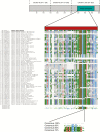EZHIP/CXorf67 mimics K27M mutated oncohistones and functions as an intrinsic inhibitor of PRC2 function in aggressive posterior fossa ependymoma
- PMID: 30923826
- PMCID: PMC6620627
- DOI: 10.1093/neuonc/noz058
EZHIP/CXorf67 mimics K27M mutated oncohistones and functions as an intrinsic inhibitor of PRC2 function in aggressive posterior fossa ependymoma
Abstract
Background: Posterior fossa A (PFA) ependymomas are one of 9 molecular groups of ependymoma. PFA tumors are mainly diagnosed in infants and young children, show a poor prognosis, and are characterized by a lack of the repressive histone H3 lysine 27 trimethylation (H3K27me3) mark. Recently, we reported overexpression of chromosome X open reading frame 67 (CXorf67) as a hallmark of PFA ependymoma and showed that CXorf67 can interact with enhancer of zeste homolog 2 (EZH2), thereby inhibiting polycomb repressive complex 2 (PRC2), but the mechanism of action remained unclear.
Methods: We performed mass spectrometry and peptide modeling analyses to identify the functional domain of CXorf67 responsible for binding and inhibition of EZH2. Our findings were validated by immunocytochemistry, western blot, and methyltransferase assays.
Results: We find that the inhibitory mechanism of CXorf67 is similar to diffuse midline gliomas harboring H3K27M mutations. A small, highly conserved peptide sequence located in the C-terminal region of CXorf67 mimics the sequence of K27M mutated histones and binds to the SET domain (Su(var)3-9/enhancer-of-zeste/trithorax) of EZH2. This interaction blocks EZH2 methyltransferase activity and inhibits PRC2 function, causing de-repression of PRC2 target genes, including genes involved in neurodevelopment.
Conclusions: Expression of CXorf67 is an oncogenic mechanism that drives H3K27 hypomethylation in PFA tumors by mimicking K27M mutated histones. Disrupting the interaction between CXorf67 and EZH2 may serve as a novel targeted therapy for PFA tumors but also for other tumors that overexpress CXorf67. Based on its function, we have renamed CXorf67 as "EZH Inhibitory Protein" (EZHIP).
© The Author(s) 2019. Published by Oxford University Press on behalf of the Society for Neuro-Oncology. All rights reserved. For permissions, please e-mail: journals.permissions@oup.com.
Figures





References
-
- Kilday JP, Rahman R, Dyer S, et al. . Pediatric ependymoma: biological perspectives. Mol Cancer Res. 2009;7(6):765–786. - PubMed
Publication types
MeSH terms
Substances
LinkOut - more resources
Full Text Sources
Other Literature Sources
Molecular Biology Databases

